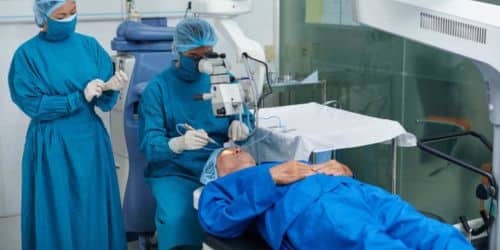A career as an ophthalmologist may appeal to you if you have a keen interest in the human visual system, eye diseases, and their medical management. Ophthalmologists are medical doctors who specialize in the treatment of eye illnesses and the relief of eye pain. However, we have different types of an ophthalmologist, such as Pediatric ophthalmologists and Neuro ophthalmologists. In this article, we listed out some steps you need to take to become a certified ophthalmologist. Enjoy the ride!
What Is an Ophthalmologist?
Eye and vision disorders are best handled by an ophthalmologist, who are medical professionals with specialized training in these areas. Then, what distinguishes an optometrist from an ophthalmologist? So, what about eye doctors? There is some overlap in the responsibilities of these three types of eye care professionals, despite their similar-sounding names. At first sight, it might not make much sense. The distinction is as follows:
Eyeglasses frames, lens materials, and coatings are all things an optician can tell you about. They cannot do eye exams, provide prescriptions, or diagnose or treat eye conditions. An ophthalmologist is trained to examine the eyes, evaluate vision, provide corrective lenses (such as glasses or contacts), and treat a wide range of eye diseases and conditions. They can’t perform surgery or diagnose diseases, but they can prescribe certain eye drugs.
An Ophthalmologist also does vision tests, diagnose and treats eye diseases, and prescribes corrective lenses. As medical professionals, they are able to identify and remedy any issue related to the eyes. They are able to both execute and oversee eye surgeries.
What Does an Ophthalmologist Do?
An ophthalmologist will check your eyesight and determine your corrective lens prescription as part of a complete eye exam. They will examine your eye alignment, your ability to focus, and the health of the muscles that control your eye movement to determine if you need corrective lenses. They will check the retina and optic nerve in the rear of your eye for any indications of diseases like cataracts or glaucoma.
Ophthalmologists are trained to identify and treat a wide range of eye problems, including infections, illnesses, and accidents. Medication used topically to the eye or taken orally are two examples of how diseases can be treated. Other options include surgery, cryotherapy (freeze treatment), and chemotherapy (chemical treatment).
Subspecialties of Ophthalmology
The following are the subspecialties of ophthalmology:
#1. General (Or Comprehensive) Ophthalmologists
They perform cataract surgery, treat a wide range of eye diseases, and provide prescription eyewear prescription glasses and contact lenses. In cases that require more specialized attention, a general ophthalmologist may suggest seeing a specialist.
#2. Refractive Surgeons
They perform refractive surgery (including LASIK, SMILE, and ASLA) and lens surgery to restore clear eyesight. Myopia, hyperopia, age-related long-sightedness (presbyopia), and astigmatism are all examples of refractive defects.
#3. Corneal Specialists
Corneal illnesses are identified and treated by the corneal specialist; the cornea is the transparent front window of the eye. Dry eye, corneal trauma, keratoconus, Surfer’s Eye (pterygium), and Fuch’s dystrophy are all examples of such disorders. These doctors may conduct corneal cross-linking and corneal transplantation (keratoplasty).
#4. Glaucoma Specialists
Glaucoma Specialists are well-trained to diagnose and treat a wide range of eye disorders, including the most frequent one, glaucoma. Medical, laser, and surgical methods all exist for properly managing ocular pressure to treat glaucoma.
#5. Retinal Specialists
Retinal Specialists treat conditions that manifest in the retina and oversee patient care. This encompasses the vitreous, the translucent jelly-like fluid that makes up most of the eye, and the retina, the light-sensitive tissue in the back of the eye responsible for central vision. Treatments include laser therapy, vitrectomy (removal of the vitreous), cryotherapy (freezing treatment), and surgery to restore torn/detached retinas, while diagnostic testing includes ultrasound, dye methods (fluorescein angiography), and electrophysiology.
#6. Oculoplastic Surgeons
Eyelid (blepharoplasty) and tear duct (lacrimal) surgery, as well as orbital (eye socket) and periocular (eyeball) surgery, are all examples of plastic surgery involving the eye and its surrounding tissues. An oculoplastic surgeon takes care of all these.
#7. Pediatric Ophthalmologist
A Pediatric Ophthalmologist is well-versed in identifying and treating children’s vision problems. Strabismus (misalignment of the eyes), amblyopia (lazy eye), and other diseases caused by hereditary and developmental defects and trauma are common. They make sure that proper treatment is given to children suffering from such.
#8. Ocular inflammation specialists
Ocular inflammation specialists are curious about the inflammatory diseases of the eye caused by immune system dysfunction (such as uveitis and scleritis). Specialists in this field have extensive training in immunotherapy and frequently collaborate with other medical immunology professionals (such as immunologists and rheumatologists).
#9. Neuro Ophthalmologist
A Neuro Ophthalmologist remediates neurological and brain-related vision impairments. Some common examples are strabismus (uneven eye movement), anisocoria (unequal pupil size), diplopia (double vision), and amblyopia (total or partial loss of one or both eyes). Strokes, brain tumors, and thyroid disorders are the potential underlying causes.
Ophthalmologist Requirements
The following are ophthalmologists requirements needed for you to become a certified ophthalmologist:
- After approximately four years of medical school
- Passing scores on two United States medical licensing exams
- Completion of a one-year internship
- Successful completion of a 36-month residency
- A bachelor’s degree with an impressive GPA
- A competitive score on the medical college admission test (MCAT)
2. Pediatric Ophthalmologist
A pediatric ophthalmologist has the training and experience to diagnose and treat eye conditions in children, including those that cause blurred or double vision, trouble with vision screening exams, reading and learning difficulties, and the need for surgery or medicinal therapy for eye diseases. Young people are not simply miniature adults. They don’t always have the words to express their frustrations. They don’t always have the answers to medical queries and struggle to remain calm and cooperative throughout exams. Children’s eyes might be difficult to inspect, but pediatric ophthalmologists have mastered the art. Pediatric ophthalmologists also benefit from the usage of specialized equipment created with kids in mind. Most pediatric ophthalmologists’ waiting rooms and exam rooms are designed with kids in mind. The exam rooms and the waiting area may contain kid-friendly amenities like books, films, and toys. This makes the setting for your youngster more relaxed and safe.
A pediatric ophthalmologist is the best person to see if your child needs an eye exam since they have the most experience working with children and the most advanced education and training in eye care.
Neuro Ophthalmologist
Neuro-ophthalmology combines the fields of neurology and ophthalmology to treat eye disorders. A Neuro ophthalmologist is trained to diagnose and treat neurological eye conditions. Vision impairments caused by trauma, stroke, or infection to the brain are one example of this category of conditions. These problems aren’t always the reason for alarm, but they can progress to much more serious complications including blindness if left untreated.
A neuro-ophthalmologist is a medical doctor who specializes in diagnosing and treating eye and vision problems that originate in the nervous system or elsewhere in the body. Electroretinography, optical coherence tomography, and multi-focal electroretinograms are all examples of possible diagnostic tools.
Neuro-ophthalmologists may recommend a variety of treatments, some of which are listed below depending on the severity of your condition.
- Optic correction
- Treatment of muscular spasms with Botox
- Surgical procedures
How To Become an Ophthalmologist
The following are the steps you need to take to become a certified ophthalmologist:
#1. Enroll in a Four-Year Institution
Students entering the field of ophthalmology are required to have a minimum of a bachelor’s degree. There is no set major you must pursue, although it is strongly advised that you enroll in a pre-med program at an accredited university. You should major in a science-related discipline if your university doesn’t offer a pre-med program. You can get a head start on your pre-med studies by choosing a college major like anatomy or biology. Earning a 3.5 or better GPA in your undergraduate studies is highly recommended if you attend medical school after graduation.
#2. Prepare for the Medical College Admissions Test
You will prepare for the Medical College Admissions Test (MCAT) during your undergraduate years. Typically, this exam is given to undergraduates in their third or fourth year of study. Getting a high MCAT score will help you stand out from other applicants in a highly competitive graduate school admissions process.
The MCAT is designed to assess your analytical reasoning, problem-solving, and general scientific knowledge. The testee can choose from a wide variety of study aids. Join a study group with other aspiring doctors and practice test questions by asking each other hypothetical scenarios. After taking the MCAT, your results will be included in your medical school application packet along with everything else.
Most medical schools consider MCAT scores of 25 or higher to be competitive. You may find out the average MCAT score for candidates to the institutions you’re interested in by contacting them directly.
#3. Apply to Medical School
Researching medical schools and their requirements is an important step to take as you near the end of your undergraduate studies. Then, you can start putting together your application packet.
The following items are necessary for a medical school application:
- Recommendations and letters
- Your undergrad GPA must be over 3.50.
- A combined grade point average in scientific courses and laboratories of at least 3.5
- With a high Medical College Admissions Test (MCAT) score
- Participation in leadership or medical-related extracurriculars
#4. Attend a School of Medicine
If you’ve been accepted to medical school, real learning and training can begin. First-year medical students focus intensely on scientific coursework. You might have classroom and laboratory experiences. Ethics in medicine, relevant law, and foundational principles in clinical care are also covered throughout the first few years of medical school. First-year medical school is excellent practice for the board test that follows.
#5. Take the First Part of the United States Medical Licensing Exam
Most medical students take this exam during their second year of study. If you pass, you’ll be able to participate in rotations and gain practical experience in the medical profession. You can expect questions on the following topics in the first section of the United States medical license exam:
- Sciences of Society
- Various Illnesses
- Comparing Abnormal and Typical Functions
- Therapeutics
- Epidemiology
- Systems and tissues
- Biostatics
#6. Begin Participating in Rotations
If you’ve already passed the first portion of the medical licensure exam, then you’re probably ready to start doing rotations. During rotations, you’ll get hands-on experience in a variety of medical specialties from a variety of doctors and physicians who will teach you the ins and outs of running a medical practice. Here is your chance to learn more about the medical field and its many subfields.
The following fields of medicine are represented in rotations:
- Neurology
- Internal medicine
- Gynecology
- Pediatrics
- Surgery
- Family medicine
#7. Take the Second Part of the U.S. Medical Licensing Exam
After completing your rotations, you will be given a test to check that you have retained the information presented throughout your practical experience. This exam will assess your clinical knowledge and readiness to operate independently in a healthcare setting, such as a hospital or clinic.
#8. Commence Your Internship
You’ll have to take an exam and then do an internship for a whole year if you want to move forward. You’ll get hands-on experience making diagnoses, administering treatments, and conducting routine examinations as you work side by side with patients and your supervisor. Internships are the capstone experience for learning the basics of several medical subspecialties. You can enter an ophthalmology residency program after completing an internship of at least a year.
#9. Receive Training from a Residency Program
You have been accepted into a residency program where you will spend the next 36 months learning the ins and outs of ophthalmology. You’ll interact directly with patients as you treat and diagnose injuries, illnesses, and conditions. In addition to working in the field, you may choose to further your education by enrolling in lectures or courses that focus on the prevention and treatment of sickness and mental illness.
#10. Identify Your Area of Expertise
During your residency, you should have come to recognize your interest in a particular area of ophthalmology. Research areas in ophthalmology could include:
- Plastic surgery of the eyelids and cornea
- Corneal disorders
- Eye care for kids
- Eye disorders
- Neuro-ophthalmology
- Eye diseases and disorders
#11. Start Looking for a Job
After you have finished your training and education, you can start looking for work in your specialism. Some subspecialty-trained ophthalmologists find employment in the same hospital or clinic where they completed their residency. Some people, though, prefer to work in other settings. Your previous managers may speak well of you and refer you to other medical facilities. They may also know of places to work, such as hospitals and workplaces, that are hiring.
You can find out what kind of education and work history is preferred for ophthalmology jobs by searching online job boards. Skills, work experience, education, training, certifications, and professional affiliations are all important additions to a resume.
When Should I Have My Eyes Examined?
One more thing you can do to safeguard the health of you and your loved ones is to get your eyes checked regularly. It’s important to schedule frequent eye exams because your eyes’ health can deteriorate over time.
- Having a child’s eyes checked at the pediatrician’s or family doctor’s office once per year to two years is recommended. This should begin about the time the youngster learns the alphabet. If vision issues are suspected, screenings should start earlier.
- Examining one’s eyes thoroughly once every five to ten years is recommended for those aged 20 to 39.
- Checking one’s eyesight every two to four years is recommended for those aged 40 to 54.
- Eye exams are recommended every one to three years for adults aged 55 to 64.
What Should I Expect from My Appointment with My Ophthalmologist?
Typical questions asked at the beginning of an eye exam include:
- Do you need glasses or contact lenses?
- Do you know what they are?
- How long have you been experiencing this issue?
- Is there anything that either helps or hinders your eyesight?
The ophthalmologist will then inquire as to whether or not you have previously worn corrective lenses. They may also inquire about your general health and the presence or absence of any eye disorders in your family.
How Long Does It Take To Become an Ophthalmologist?
After obtaining an MD, ophthalmologists must complete an additional four years of residency training in order to practice as generalists. This comprises an internship of at least one year and then a three-year residency in ophthalmology (eye surgery) at an accredited surgical residency school.
How Much Does Ophthalmologists Make?
The average salary for an ophthalmologist in the United States is around $200,890 per year.
Final Thoughts
Ophthalmologists might select from a wide range of workplaces. Both single- and multi-specialty group practices will employ some of these professionals. They can operate in a variety of settings, including hospitals, clinics, private offices, and universities, where they focus primarily on research. Ophthalmologists typically diagnose and treat between 80 and 100 patients per week. It is a very lucrative job! Why not take this bold step today if this had been your dream job?
Related Articles
- Five Health risks you might encounter at the Nail Salon
- NOSE SURGERY COST: Comprehensive Cost Breakdown For All Scenarios (Updated)
- EMERGENCY MEDICINE SALARY: How Much Does Emergency Physician Make
- SEO SPECIALISTS: Definition, Salary, Duties & How to Become One






